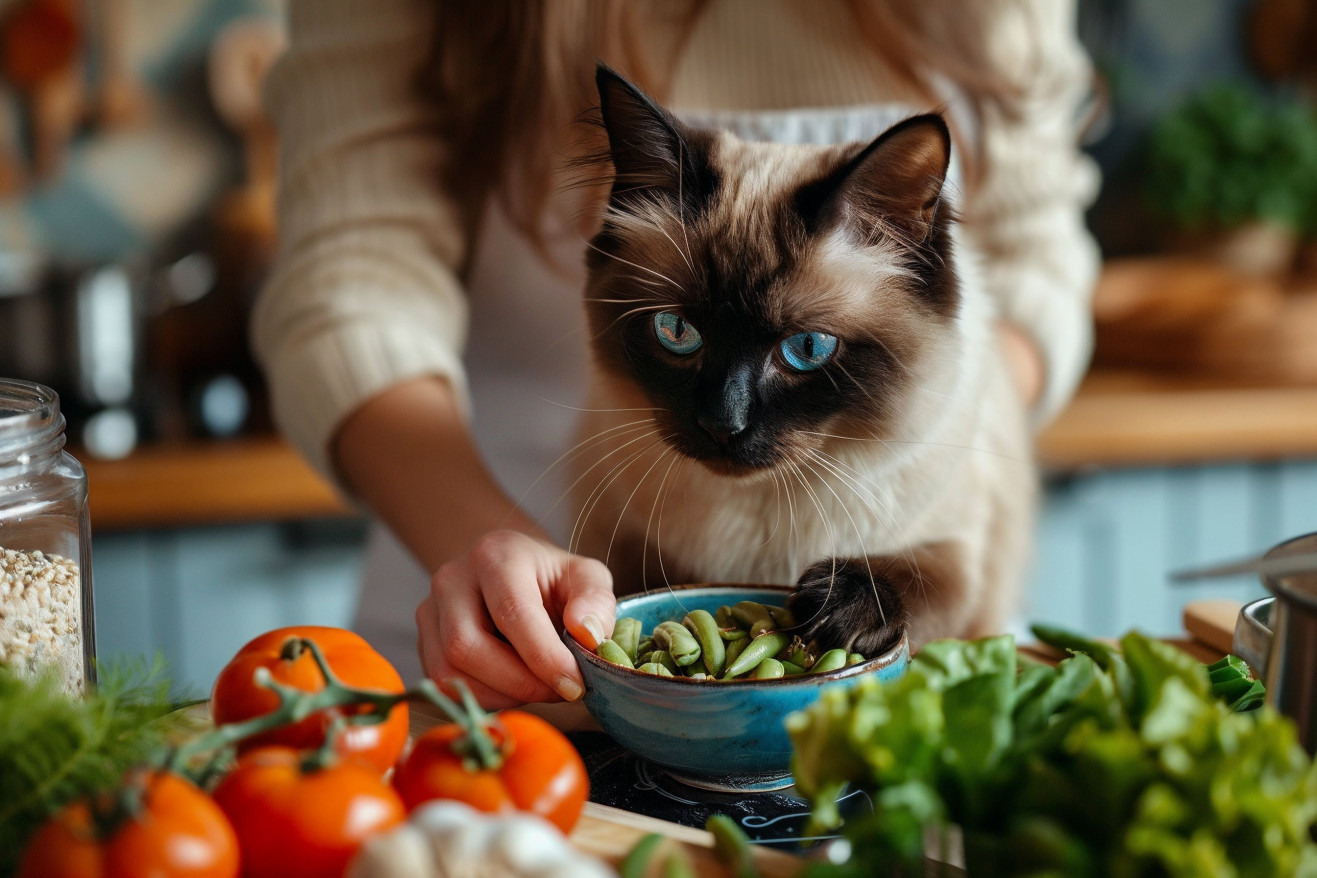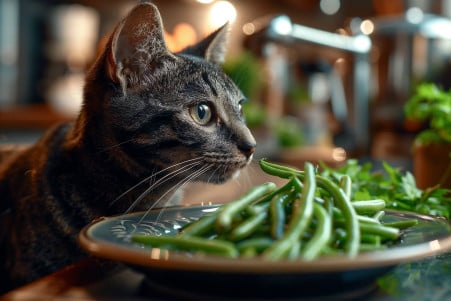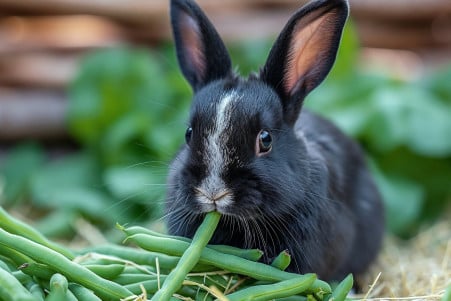Can Cats Have Green Beans? A Nutritional Guide for Pet Parents
15 February 2024 • Updated 14 February 2024

Green beans are a common part of many people’s diets, but can the same be said for cats? The answer is yes, cats can eat green beans and they can even be a good source of fiber and protein for your pet.
That said, green beans should only be given to cats as a treat and in moderation. And, as always, you should introduce new foods slowly and talk to your vet before making any major changes to your cat’s diet.
This article will look at research and nutritional information to help you better understand the potential benefits and drawbacks of adding green beans to your cat’s diet. It will also take a close look at cats’ nutritional needs as obligate carnivores and how green beans can (or can’t) help meet those needs.
By the end of this article, you’ll have a good idea of how to use green beans to help ensure your cat’s diet is as healthy and balanced as possible.
Can cats have green beans?
What Nutrients Do Green Beans Provide for Cats?
Green beans are full of nutrients that can be good for your cat. According to Healthline, green beans are a good source of vitamins A, C, and K, and are rich in minerals like calcium and iron. In fact, a single cup of raw green beans has almost 2 grams of protein, which is important for a cat’s muscles and organs.
WebMD also notes that green beans are low in calories, which could make them a good option for cats that are overweight, although it’s important to work with a vet to ensure that any weight loss plan is safe and healthy. Green beans are also full of antioxidants, including vitamin C and flavonols, that can help protect cells from damage, although more research is needed to determine how these antioxidants impact a cat’s health.
It’s important to note, as Medical News Today points out, that if you’re going to feed your cat green beans, you should choose fresh or frozen green beans over canned ones, which can be high in sodium and not good for your cat’s heart.
Cleveland Clinic also recommends using fresh green beans when you’re feeding them to your cat to ensure that they get the most nutritional value and says that you should wash them and cut them into small pieces to make sure that your cat doesn’t choke.
It’s also important to make sure that you’re feeding your cat green beans in moderation, and that you’re feeding them in addition to, not in place of, a balanced, protein-rich diet.
The Carnivorous Nature of Cats and the Place of Green Beans
Cats are obligate carnivores, meaning that their bodies are designed to get the nutrients that they need from a diet that’s primarily made up of animal protein. VCA Animal Hospitals explains that cats don’t have the enzymes that are necessary to break down plant material, which means that they need to eat meat. The nutrients that cats need, like taurine and arachidonic acid, are typically found in animal products and not in plants.
While green beans have vitamins, minerals, and fiber that can be good for cats, they don’t have the full range of nutrients that cats need. For example, According to UK Pet Food, cats can’t make taurine, an amino acid that’s important for vision and heart health, so they need to get it from their diet, which is primarily made up of animal products.
Similarly, arachidonic acid, an omega-6 fatty acid, is only found in animal fats, not in green beans.
That said, green beans can be a good addition to a balanced diet that’s made for cats because they can add fiber and other nutrients. Cornell University College of Veterinary Medicine says that treats should make up no more than 10–15% of a cat’s daily calories, so green beans could be a good occasional treat.
However, it’s important to note that while green beans can be a good addition to a cat’s diet, they don’t have the nutrients that cats need to get from animal products.
How Green Beans Affect a Cat’s Digestion
Cats are obligate carnivores, which means their digestive system is designed to meet the needs of a diet that’s high in animal-based proteins. According to the Veterinary Teaching Hospital at Washington State University, the feline gastrointestinal tract, which includes the mouth, stomach, and intestines, is highly specialized to digest and absorb nutrients from meat.
When it comes to plant-based foods like green beans, cats digest them differently than their natural prey. A study published in PMC explains that cats can adapt to digesting more protein from plants when they switch from an animal protein to a plant protein diet, but their digestive system still prioritizes animal-based nutrients. This means that green beans, as a plant-based protein source, may not be as easily absorbed for their protein as meat.
That said, green beans can help increase the fiber in a cat’s diet, which is good for digestion. However, the study also explains that increasing the fiber in a cat’s diet can decrease the digestibility of other nutrients. As a result, it’s important to add green beans to a cat’s diet slowly and in small amounts to avoid disrupting the cat’s digestion and nutrient absorption.
Pet parents should add green beans to their cat’s diet slowly and in moderation to make sure they’re getting the benefits without any digestive issues. They should also watch for changes in their cat’s digestion and stool quality and work with their veterinarian to make sure their cat’s diet is tailored to their specific needs.
Assessing the Impact of Plant-Based Foods on Cat Health
The question of whether vegan diets are safe for cats is complex. A systematic review on PMC notes that while there are concerns about nutrient deficiencies, especially in taurine, vitamin B12, and B9, there is no clear evidence that cats on vegan diets are at risk for serious health problems.
The review does, however, caution against vegan diets for cats and recommends that cat owners only use commercial vegan cat foods that have been specifically formulated to meet feline nutritional requirements.
On the other hand, a study reported on in PLOS ONE found that cats on vegan diets had fewer health problems and required fewer trips to the vet. However, the study’s small sample size and reliance on survey data means that more research is needed to determine if these findings are accurate.
Cats fed plant-based diets are at risk for nutrient deficiencies, especially in taurine, vitamin B12, and B9, which are typically found in animal products. This can lead to health problems, including dilated cardiomyopathy and poor reproductive health. However, there are some potential benefits to non-meat foods, including the possibility that the fiber in green beans could help with digestion.
More research is needed to determine the long-term impact of plant-based foods on cats to make sure that cats are getting the nutrition they need to stay healthy and thrive. As always, cat owners should consult with their veterinarians before making any changes to their pets’ diets.
How to Add Green Beans to Your Cat’s Diet
If you want to add green beans to your cat’s diet, it can be a healthy way to give them a treat, especially if they are on a diet. Because green beans are low in calories and high in fiber, they can be a good occasional treat for your cat.
CatTime recommends that you start by adding a small amount of green beans to your cat’s diet, no more than 10% of their regular meal, to avoid stomach upset.
To prepare green beans for your cat, you can simply steam or boil them until they are soft. Just be sure not to add any seasonings that could be toxic to your cat. Cut them into small, bite-sized pieces to avoid choking and make them easier for your cat to eat. SpotPetIns recommends that you serve cooked green beans without any additional ingredients to ensure that they are safe for your cat.
If you are using green beans as part of a weight loss plan for your cat, you should always monitor them closely and introduce them slowly.
You should also pay close attention to how your cat reacts to the new food. If your cat doesn’t show any signs of a bad reaction, such as stomach upset or an allergic reaction, you can increase the amount of green beans that you give them slowly and with the help of your vet.
However, it’s important to note that while green beans can be a healthy addition to your cat’s diet, they should never replace your cat’s regular diet of formulated cat food. Always talk to your vet before making any changes to your pet’s diet.
In Conclusion: Green Beans in a Cat’s Diet
As we’ve discussed in this article, green beans can be a healthy addition to your cat’s diet, providing fiber, a variety of vitamins and minerals, and few calories. As CatTime pointed out, this can help cats maintain a healthy weight. That said, it’s important to remember that green beans should be given in moderation and can’t replace the meat-based nutrients that cats need as obligate carnivores.
Always consult with a vet before adding new foods like green beans to your cat’s diet to make sure they are helping and not hurting your cat’s balanced diet. While green beans can be a good addition to a cat’s diet, as Healthline noted, they aren’t necessary and should only be added to a diet that already meets all of a cat’s nutritional requirements.
In summary, keep learning and talking about the potential benefits of different foods in a cat’s diet. This will only help improve the health of our beloved pets. When given in the right way, green beans can be a nutritious treat that helps cats maintain a well-rounded and healthy diet.


